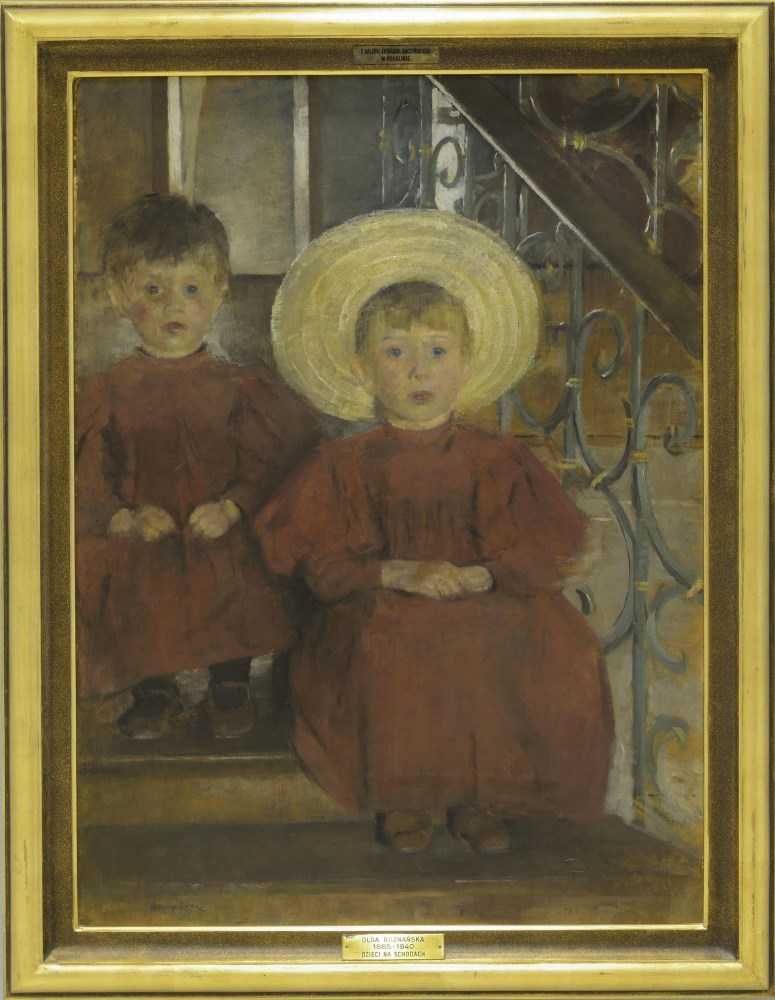Description:
Olga Boznańska’s (1865-1940) education began with private drawing lessons and then she attended the Women’s Courses of Baraniecki in Krakow. As a woman, she could not be a student at the Academy. An important stage of her education was her stay in Munich and visits to European museums, where she was amazed by Velázquez, Monet and Whistler. Her goal was Paris, and it is there that she settled and started a workshop after first successes at exhibitions throughout Europe. She painted landscapes, still lifes, interior scenes and moody portraits, for which she became famous.
The painting depicts a pair of children who have crouched on the stairs. They are dressed in matching red dresses, which children still wore at the time regardless of gender. The child on the lower step has a large straw hat on their head. The small models sit quite stiffly, obediently and quietly. There is something strange and unnatural in this peace, as if it does not go with their age.
Description of the painting:
The scene appears to be ordinary. Two children have perched on the stairs. The choice of location seems to suggest a certain childish freedom, emphasized by a warm color palette. They are dressed in long dresses, which were still worn by small children, regardless of gender, at the turn of the 19th and 20th centuries. They sit quite politely, somewhat stiff, forced to pose for hours. Upon a second glance at the painting, something in the scene starts to become unsettling.
It is hard to determine the expression on the children’s faces, where one can read concentration, tension, contemplation or even bewilderment, and at the same time an absent gaze dictated by weariness. There is a certain stiffness in their silhouettes, an unnatural gravity for this age, and a sadness, elusive until the end and yet present. As if the children already had an adult look. The child cheeks are covered with blushes. Did they emerge on pale faces out of shame, fear, or did the artist capture the moment when, after playing, the children were seated again in their places, to stay for the next hours of posing?
More than the petrified silhouettes and undecipherable expressions of faces, the gestures of hands tell a lot, particularly that of the smaller child. The older one, sitting in the front, neatly places them on their lap, a gesture that was no doubt observed from adults, as folded hands hide feelings. The younger child clasps their fists on their knees, as if struggling to hold back, appearing much less composed than the older companion. It is also hard to determine the gender of the children, due to the lack of obvious attributes or clothes, although it can be guessed that the smaller child is a boy, while the one adorned with a hat is a young lady.
This aforementioned anxiety emanating from the observation of the image stems from the aforementioned contradictions, but also from the impression of separation of the figures in the image. They do not enter into a relationship with the viewer, instead passing him by with their gaze. The matte surface of the image that Boznańska consciously achieved by painting with a dry brush on an unprimed cardboard creates a kind of barrier, an invisible Venetian window, which allows one to look at the children but does not allow for establishing contact with them. They remain in their own world, indifferent, frozen, neither going down the stairs nor going up.


